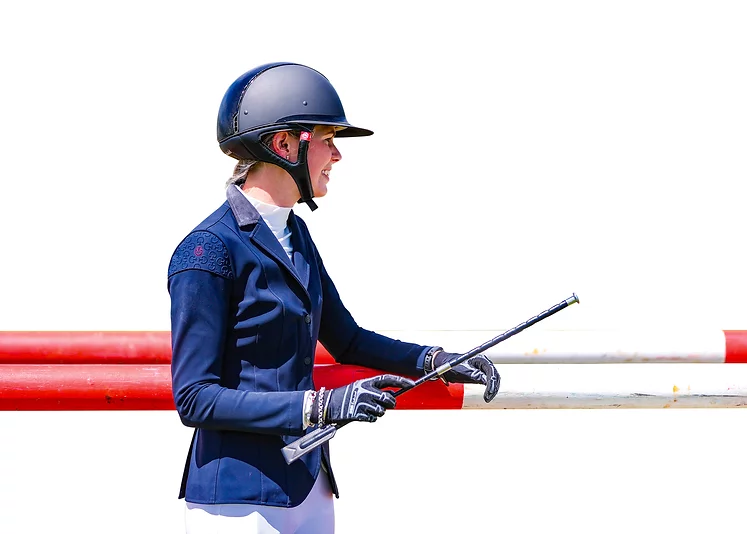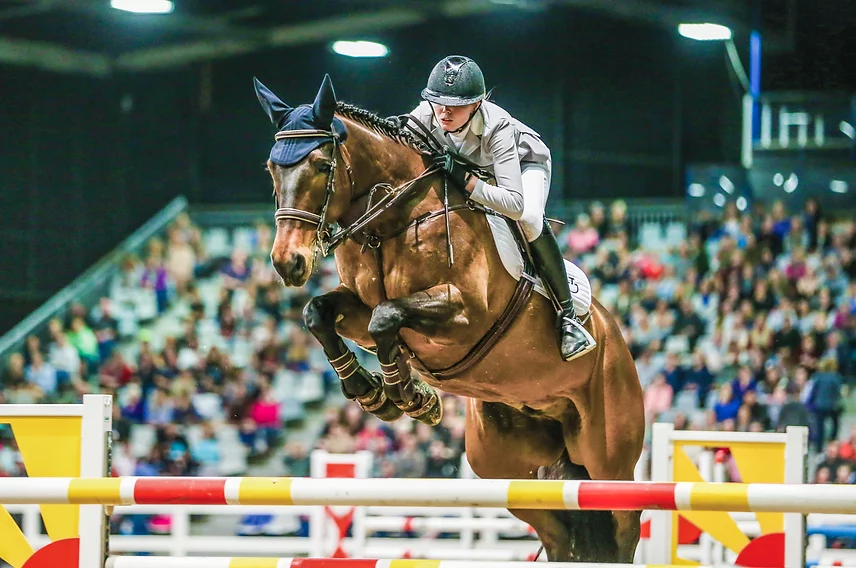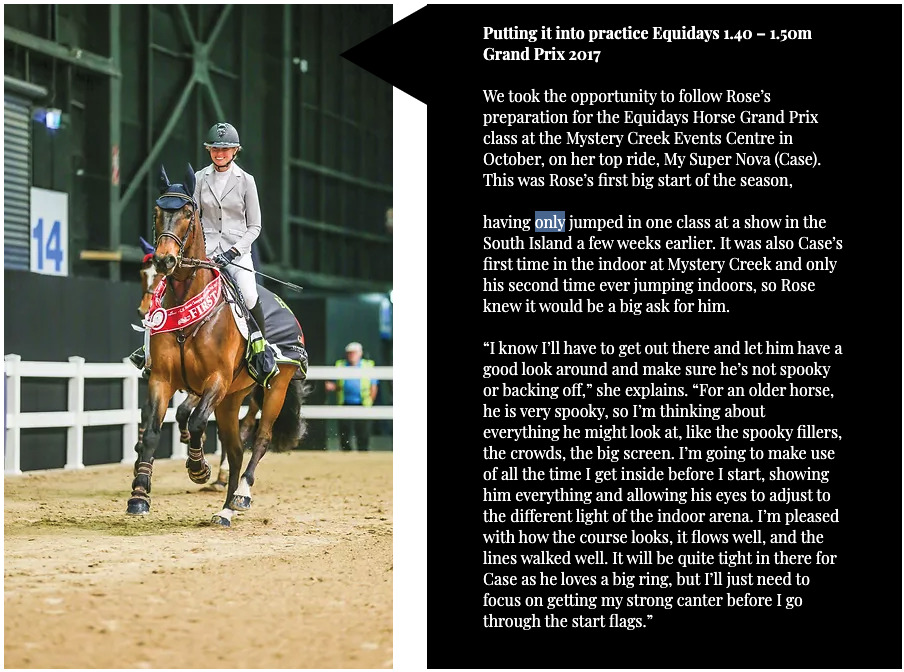- New Zealand
Complete Class Prep
- Training
-
Mar 05
- Share post

– Jumping with Rose Alfeld –
Walking your course and warming up for a class are the final stages after weeks, months, even years of preparation to get to a competition, and getting those elements right can make the difference between a good performance and a bad one. We sat down with show jumping rider, Rose Alfeld, to learn how she prepares for her classes with her team of horses and followed her preparation for the Grand Prix class at Equidays in October 2017.
A thorough course walk
Rose can’t stress enough the importance of a thorough course walk, and she has several suggestions to help you make the most of it and to prepare for your best possible performance.
Get out there early and make a plan
Rose recommends getting out into the arena as soon as the course is set so that you have time to plan and can reflect on the course before you get on your horse.
“As you’re walking, start making a plan, factoring in your own horse’s way of going and concentrating on what you’re doing – not talking to friends,” she says. “You need to know your plan off by heart, and even though it might change along the way, you’re much better off going in with a plan than not. Once I’m finished walking the actual course, I like to go through it a few times in my head, making sure I know exactly where I’m going and repeat to myself all the distances that I plan to ride between fences.”

Have someone on hand
While Rose likes to walk the actual course on her own to allow full concentration, she still thinks it’s essential to have someone around to talk to, that knows your riding and your horse well.
“I like to walk the course on my own, but when I come out of the ring, I will bounce ideas off Mum, and tell her my plan. It’s mostly just so I can reconfirm and go over again what I’m doing, which is essential,” she says.
Rose acknowledges that in many cases, particularly with younger riders, it is beneficial to walk with someone who can help and offer guidance.
“If you’re walking the course with someone, make it a senior rider, coach, or parent that is going to give you positive advice.”
Stay calm
Rose says it is crucial to stay calm walking the course, even if it’s a little more technical or bigger than you may have expected.
“I always try not to get nervous, and stay cool, calm and collected by believing in the training work I’ve done at home and reminding myself that I’m ready for the class I’ve entered. A positive attitude is essential – you need to go out there, believing you can do it.”

Think about your horse
With several horses in her team, Rose says she walks each course with the horse/s that she is going to ride the course on in mind and says that even if you only have one horse, it’s essential to know what will and won’t suit them in the ring.
“Every horse is different and needs a different ride, and there are different factors that need to be considered with all of them,” she says. “For example, my top horse, My Super Nova, has got a massive stride and can be spooky, so I will walk the course for him thinking about how I will manage the striding and anything inside or outside the ring which he might spook at.”
Rose likes to watch a few horses go before she gets on to warm-up, if possible.
“I like to see how the course is riding if I can, but I don’t talk to lots of other people about different striding and how things are riding because I know how a line will work for my horse better than anyone. I will stick to my plan unless I am sure of a good reason to change it.”
A tailored warm-up
As with the course walk, Rose stresses the importance of having a warm-up plan based on what suits your horse, without worrying about what others are doing.
“You need to know your horse and have the confidence to believe in what you’re doing in the warm-up and what works for your horse. The warm-up ring is not a time to change things! Everything has been practised at home, and the warm-up is the chance to give yourself and your horse confidence before you go into the ring.”
Focus on the canter
Rose’s warm-up usually takes about half an hour in total, involving plenty of walking and stretching to loosen the horse’s muscles, before doing a little bit of trot work, incorporating plenty of bending to make sure the horse is listening to her aids.
“Once they are ready, I spend most of the flat warm-up working on the canter, because that is what you need to jump from,” says Rose. “I work on getting the strong canter that I need in the ring and get it to a point where I have the adjustability I need before moving on to jumping.”
Eyes on the ground
Rose is grateful to have the support of her mum, Lisa, on the ground at competitions and finds her eyes and ears on the ground invaluable in allowing her to have a focused warm-up.
“I like having someone on the ground to check how far away I am and to follow the class while I’m warming up on the flat, to tell me if there any issues with the course, like one fence catching people out,” she says. “I also think that everybody needs someone in the warm-up to adjust fences so you can jump what you want to, rather than what’s there at the time. It’s also good to have someone just to provide positive reinforcement. I don’t want a full lesson at the practice fence, just someone reminding me to travel forward in a strong canter.”
Don’t over jump
When she’s ready to head to the practice fence, Rose usually limits her warm-up to about ten fences in total. “I don’t like to do much jumping in the warm-up. I usually jump a couple of crossbars, a smaller upright and a little oxer, then we catch our breath and have a walk before putting the fences up bigger. It’s normally about ten fences, including the crossbar, for most of my horses,” she says.
If the first fence on the course is an oxer, Rose will usually jump one big oxer before she goes in.
“That last oxer will always be about the height of the class, so I know that I have a good enough canter going to make the oxers in the ring. I aim to be finished warming up in time to watch the horse before me, and give my horse a breather before we go into the ring.”
Adjust accordingly for your horse
Just like when you’re walking the course, Rose says it is essential to know what kind of warm-up works for your horse and adjust it to suit that horse.
“For example, with my six-year-old, Cadenza NZPH, I know I’m usually lucky to get to jump one or two fences in the practice arena because he is very quirky. I do my flat warm-up in a quiet area and then brave the practice arena for one or two fences before heading straight in. It’s a bit different, but I’ve gotten to know what works for him and there’s no use letting him get wound up. Your plan is allowed to be different from what others are doing if that is what works for your horse.”

As this is his first big class of the season, Rose wants to focus on giving Case plenty of confidence in the warm-up, and even though it’s a tight ring, she won’t be turning him tighter than usual in the practice arena to prepare.
“I know he can turn up when I need him to and we do all of that training at home. I just want him to go in as confident as possible,” she says.
After a great warm-up, Rose and Case start brilliantly and are going clear right up until the last line, where she comes unseated over fence 11 and can’t get organised in time to get down to the narrow final fence four strides away. They have an unfortunate run out, and then four-time penalties are added, leaving them on a total of eight.
“I was super happy with the way he jumped, just a little disappointed with the run-out!” Rose tells us. “He just spooked, and I didn’t have time to get organised after getting unseated at fence 11.”
Coming back in tenth position for the second round meant that Rose was first to go, and she knew that it was important to put the disappointment of round one behind her and go for a quick clear, which she and Case managed easily. As faults came thick and fast for the remaining nine riders, Rose’s eight fault total ended up being the best on the night, and to her surprise, she clinched the win and took home $5,000 in prize money.
“I knew that he wouldn’t be so spooky [in round two] because he’d jumped around already, so my strategy was just to set the standard for the second round and jump a good clear. I thought I’d be in for a chance at a place, but I never expected to win!” With several horses in her team, Rose says she walks each course with the horse/s that she is going to ride the course on in mind, and says that even if you only have one horse, it’s important to know what will and won’t suit them in the ring.
“Every horse is different and needs a different ride, and there are different factors that need to be considered with all of them,” she says. “For example, my top horse, My Super Nova, has got a massive stride and can be spooky, so I will walk the course for him thinking about how I will manage the striding and anything inside or outside the ring which he might spook at.”
Rose likes to watch a few horses go before she gets on to warm-up, if possible.
“I like to see how the course is riding, if I can, but I don’t talk to lots of other people about different striding and how things are riding, because I know how a line will work for my horse better than anyone. I will stick to my plan, unless I am sure of a good reason to change it.”
Reproduced with kind permission from Show Circuit.
Comments
Add a comment
Leave a Reply · Cancel reply
You must be logged in to post a comment.

